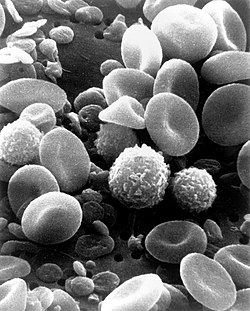
Back Witbloedsel Afrikaans Leukozyt ALS Leucocito AN خلية دم بيضاء Arabic শ্বেত ৰক্ত কণিকা Assamese Leucocitu AST Leykositlər Azerbaijani Лейкоциттар Bashkir Лейкацыты Byelorussian Леўкацыт BE-X-OLD
| White blood cell | |
|---|---|
 A scanning electron microscope image of normal circulating human blood. In addition to the irregularly shaped leukocytes, both red blood cells and many small disc-shaped platelets are visible. | |
| Details | |
| System | Immune system |
| Identifiers | |
| Acronym(s) | WBC |
| MeSH | D007962 |
| TH | H2.00.04.1.02001 |
| FMA | 62852 |
| Anatomical terms of microanatomy | |
White blood cells (scientific name leukocytes), also called immune cells or immunocytes, are cells of the immune system that are involved in protecting the body against both infectious disease and foreign invaders. White blood cells include three main subtypes: granulocytes, lymphocytes and monocytes.[1]
All white blood cells are produced and derived from multipotent cells in the bone marrow known as hematopoietic stem cells.[2] Leukocytes are found throughout the body, including the blood and lymphatic system.[3] All white blood cells have nuclei, which distinguishes them from the other blood cells, the anucleated red blood cells (RBCs) and platelets. The different white blood cells are usually classified by cell lineage (myeloid cells or lymphoid cells). White blood cells are part of the body's immune system. They help the body fight infection and other diseases. Types of white blood cells are granulocytes (neutrophils, eosinophils, and basophils), and agranulocytes (monocytes, and lymphocytes (T cells and B cells)).[4] Myeloid cells (myelocytes) include neutrophils, eosinophils, mast cells, basophils, and monocytes.[5] Monocytes are further subdivided into dendritic cells and macrophages. Monocytes, macrophages, and neutrophils are phagocytic. Lymphoid cells (lymphocytes) include T cells (subdivided into helper T cells, memory T cells, cytotoxic T cells), B cells (subdivided into plasma cells and memory B cells), and natural killer cells. Historically, white blood cells were classified by their physical characteristics (granulocytes and agranulocytes), but this classification system is less frequently used now. Produced in the bone marrow, white blood cells defend the body against infections and disease. An excess of white blood cells is usually due to infection or inflammation. Less commonly, a high white blood cell count could indicate certain blood cancers or bone marrow disorders.
The number of leukocytes in the blood is often an indicator of disease, and thus the white blood cell count is an important subset of the complete blood count. The normal white cell count is usually between 4 × 109/L and 1.1 × 1010/L. In the US, this is usually expressed as 4,000 to 11,000 white blood cells per microliter of blood.[6] White blood cells make up approximately 1% of the total blood volume in a healthy adult,[7] making them substantially less numerous than the red blood cells at 40% to 45%. However, this 1% of the blood makes a large difference to health, because immunity depends on it. An increase in the number of leukocytes over the upper limits is called leukocytosis. It is normal when it is part of healthy immune responses, which happen frequently. It is occasionally abnormal, when it is neoplastic or autoimmune in origin. A decrease below the lower limit is called leukopenia. This indicates a weakened immune system.
- ^ "leukocyte". www.cancer.gov. 2 February 2011. Retrieved 20 April 2023.
- ^ Monga I, Kaur K, Dhanda S (March 2022). "Revisiting hematopoiesis: applications of the bulk and single-cell transcriptomics dissecting transcriptional heterogeneity in hematopoietic stem cells". Briefings in Functional Genomics. 21 (3): 159–176. doi:10.1093/bfgp/elac002. PMID 35265979.
- ^ Maton D, Hopkins J, McLaughlin CW, Johnson S, Warner MQ, LaHart D, Wright JD, Kulkarni DV (1997). Human Biology and Health. Englewood Cliffs, New Jersey, US: Prentice Hall. ISBN 0-13-981176-1.
- ^ "Definition of white blood cell". www.cancer.gov. 2 February 2011. Retrieved 15 March 2023.
- ^ LaFleur-Brooks M (2008). Exploring Medical Language: A Student-Directed Approach (7th ed.). St. Louis, Missouri, US: Mosby Elsevier. p. 398. ISBN 978-0-323-04950-4.
- ^ "Vital and Health Statistics Series 11, No. 247 (03/2005)" (PDF). Retrieved 2 February 2014.
- ^ Alberts B, Johnson A, Lewis M, Raff M, Roberts K, Walter P (2002). "Leukocyte also known as macrophagesfunctions and percentage breakdown". Molecular Biology of the Cell (4th ed.). New York: Garland Science. ISBN 0-8153-4072-9.
© MMXXIII Rich X Search. We shall prevail. All rights reserved. Rich X Search